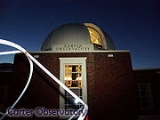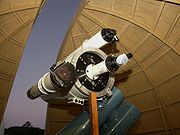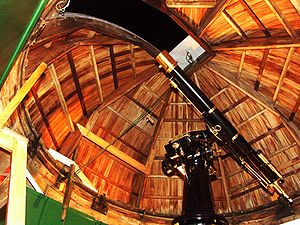
Carter Observatory
Encyclopedia
The Carter Observatory stands at the top of the Botanic Garden
s in Wellington
, New Zealand
. It re-opened in March 2010 following a NZ$
5 million refurbishment, with a new exhibition and digital planetarium celebrating the culture, heritage and science of the Southern Skies.
, who gifted his estate to what later became the Royal Society of New Zealand
for the purposes of establishing an astronomical observatory in or near Wellington. Parliament established the Carter Observatory in 1937; it opened in 1941, following some delays caused by the beginnings of World War II
.
The observatory became a base for astronomical research in New Zealand. Research began with solar investigations and when new staff joined during the 1970s it expanded to variable star
s, galaxies
, comet
s and asteroid
s. The observatory has had formal research programmes and assists amateur astronomers
to perform their own research.
The Carter Observatory became New Zealand's National Observatory in 1977. In recent years, its role "shifted from a focus on research to increasingly concentrate on public education about space" .
The Ministry of Research, Science and Technology
commissioned astronomer Professor Mike Bessell, Australian National University
, to review Carter Observatory’s ability to carry out its functions as New Zealand's National Observatory, to explore New Zealand’s requirements and the opportunities in the National Observatory area, and assess the roles of the various players within the sector. Professor Bessell's report was published in February 2005 .
s within its main building and a third telescope nearby. The Thomas Cooke telescope, an historic 9 3/4-inch Cooke Refractor named after Thomas Cooke
, serves primarily for public observing sessions. The Ruth Crisp telescope, described below, arrived as a donation in the 1960s. Not far from its main building, the Carter Observatory operates the Thomas King
Observatory, used until recently for public viewing of the sun
.
 The Ruth Crisp Telescope, a research-grade 41-cm (16-inch) Cassegrain reflector
The Ruth Crisp Telescope, a research-grade 41-cm (16-inch) Cassegrain reflector
made by Boller and Chivens
of the USA came to the observatory in the 1960s thanks to a donation by the New Zealand writer and philanthropist Ruth Crisp. Once used for research at the Carter Observatory's outstation at Black Birch, in the South Island
of New Zealand, it later moved to the main premises in Wellington.
A grant from Pub Charity allowed improvements to the installation in December 2005: the Observatory had the dome motorised and the primary and secondary mirrors re-aluminised. Efforts have commenced to start a research programme based around the facility, possibly involving deep-sky imaging, microlensing
capability and photometry
.
 The Carter Observatory also operates the nearby Thomas King Observatory
The Carter Observatory also operates the nearby Thomas King Observatory
. Astronomers have maintained its 12.5 cm (5-inch) telescope (made in 1882 by Grubb in Dublin) in good condition throughout its nearly 125-year history.
Last refurbished in May 2001, the Thomas King telescope served until recently for public viewing of the sun
, with a hydrogen-alpha filter attached. The filter has since transferred to a telescope mounted to the side of the Thomas Cooke refractor in the main observatory building.
Wellington Botanic Garden
The Wellington Botanic Garden, Wellington, New Zealand, covers 25 hectares of land on the side of the hill between Thorndon and Kelburn, near central Wellington....
s in Wellington
Wellington
Wellington is the capital city and third most populous urban area of New Zealand, although it is likely to have surpassed Christchurch due to the exodus following the Canterbury Earthquake. It is at the southwestern tip of the North Island, between Cook Strait and the Rimutaka Range...
, New Zealand
New Zealand
New Zealand is an island country in the south-western Pacific Ocean comprising two main landmasses and numerous smaller islands. The country is situated some east of Australia across the Tasman Sea, and roughly south of the Pacific island nations of New Caledonia, Fiji, and Tonga...
. It re-opened in March 2010 following a NZ$
New Zealand dollar
The New Zealand dollar is the currency of New Zealand. It also circulates in the Cook Islands , Niue, Tokelau, and the Pitcairn Islands. It is divided into 100 cents....
5 million refurbishment, with a new exhibition and digital planetarium celebrating the culture, heritage and science of the Southern Skies.
History
The name commemorates Charles Rooking CarterCharles Rooking Carter
Charles Rooking Carter was an New Zealand contractor, politician, and philanthropist from England.-Biography:Carter was born in Kendal, Westmorland, the son of a builder, John Carter. Carter lived in London from the age of 21 and through adult education classes at the Westminster Institution,...
, who gifted his estate to what later became the Royal Society of New Zealand
Royal Society of New Zealand
The Royal Society of New Zealand , known as the New Zealand Institute before 1933, was established in 1867 to co-ordinate and assist the activities of a number of regional research societies including the Auckland Institute, the Wellington Philosophical Society, the Philosophical Institute of...
for the purposes of establishing an astronomical observatory in or near Wellington. Parliament established the Carter Observatory in 1937; it opened in 1941, following some delays caused by the beginnings of World War II
World War II
World War II, or the Second World War , was a global conflict lasting from 1939 to 1945, involving most of the world's nations—including all of the great powers—eventually forming two opposing military alliances: the Allies and the Axis...
.
The observatory became a base for astronomical research in New Zealand. Research began with solar investigations and when new staff joined during the 1970s it expanded to variable star
Variable star
A star is classified as variable if its apparent magnitude as seen from Earth changes over time, whether the changes are due to variations in the star's actual luminosity, or to variations in the amount of the star's light that is blocked from reaching Earth...
s, galaxies
Galaxy
A galaxy is a massive, gravitationally bound system that consists of stars and stellar remnants, an interstellar medium of gas and dust, and an important but poorly understood component tentatively dubbed dark matter. The word galaxy is derived from the Greek galaxias , literally "milky", a...
, comet
Comet
A comet is an icy small Solar System body that, when close enough to the Sun, displays a visible coma and sometimes also a tail. These phenomena are both due to the effects of solar radiation and the solar wind upon the nucleus of the comet...
s and asteroid
Asteroid
Asteroids are a class of small Solar System bodies in orbit around the Sun. They have also been called planetoids, especially the larger ones...
s. The observatory has had formal research programmes and assists amateur astronomers
Amateur astronomy
Amateur astronomy, also called backyard astronomy and stargazing, is a hobby whose participants enjoy watching the night sky , and the plethora of objects found in it, mainly with portable telescopes and binoculars...
to perform their own research.
The Carter Observatory became New Zealand's National Observatory in 1977. In recent years, its role "shifted from a focus on research to increasingly concentrate on public education about space" .
The Ministry of Research, Science and Technology
Ministry of Research, Science and Technology (New Zealand)
The Ministry of Research, Science and Technology was a government agency within the New Zealand government.Its main responsibilities were to:* Manage the Government's research, science and technology investment...
commissioned astronomer Professor Mike Bessell, Australian National University
Australian National University
The Australian National University is a teaching and research university located in the Australian capital, Canberra.As of 2009, the ANU employs 3,945 administrative staff who teach approximately 10,000 undergraduates, and 7,500 postgraduate students...
, to review Carter Observatory’s ability to carry out its functions as New Zealand's National Observatory, to explore New Zealand’s requirements and the opportunities in the National Observatory area, and assess the roles of the various players within the sector. Professor Bessell's report was published in February 2005 .
Facilities
The Carter Observatory houses two main telescopeTelescope
A telescope is an instrument that aids in the observation of remote objects by collecting electromagnetic radiation . The first known practical telescopes were invented in the Netherlands at the beginning of the 1600s , using glass lenses...
s within its main building and a third telescope nearby. The Thomas Cooke telescope, an historic 9 3/4-inch Cooke Refractor named after Thomas Cooke
Thomas Cooke
This page is about the instrument maker. For other persons named Thomas Cooke, see Thomas CookeThomas Cooke was a British instrument maker based on York. He founded T. Cooke & Sons, the instrument company-Life:...
, serves primarily for public observing sessions. The Ruth Crisp telescope, described below, arrived as a donation in the 1960s. Not far from its main building, the Carter Observatory operates the Thomas King
Thomas King (New Zealand)
Thomas King was a New Zealand astronomer.-Early life:King was born in Glasgow, Scotland and came to Auckland with his parents as an infant. He was educated at Auckland Grammar School...
Observatory, used until recently for public viewing of the sun
Sun
The Sun is the star at the center of the Solar System. It is almost perfectly spherical and consists of hot plasma interwoven with magnetic fields...
.
The Ruth Crisp Telescope

Cassegrain reflector
The Cassegrain reflector is a combination of a primary concave mirror and a secondary convex mirror, often used in optical telescopes and radio antennas....
made by Boller and Chivens
Boller and Chivens
Boller and Chivens was an American manufacturer of high-quality telescopes and spectrographs founded about 1946 by Harry B. Boller and Clyde C. Chivens . Headquartered in South Pasadena, California, the company was acquired in 1965 by Perkin-Elmer...
of the USA came to the observatory in the 1960s thanks to a donation by the New Zealand writer and philanthropist Ruth Crisp. Once used for research at the Carter Observatory's outstation at Black Birch, in the South Island
South Island
The South Island is the larger of the two major islands of New Zealand, the other being the more populous North Island. It is bordered to the north by Cook Strait, to the west by the Tasman Sea, to the south and east by the Pacific Ocean...
of New Zealand, it later moved to the main premises in Wellington.
A grant from Pub Charity allowed improvements to the installation in December 2005: the Observatory had the dome motorised and the primary and secondary mirrors re-aluminised. Efforts have commenced to start a research programme based around the facility, possibly involving deep-sky imaging, microlensing
Gravitational microlensing
Gravitational microlensing is an astronomical phenomenon due to the gravitational lens effect. It can be used to detect objects ranging from the mass of a planet to the mass of a star, regardless of the light they emit. Typically, astronomers can only detect bright objects that emit lots of light ...
capability and photometry
Photometry (astronomy)
Photometry is a technique of astronomy concerned with measuring the flux, or intensity of an astronomical object's electromagnetic radiation...
.
The Thomas King Observatory

Thomas King Observatory
The Thomas King Observatory stands at the top of the Botanic Garden in Wellington, New Zealand, as part of the Carter Observatory. In the past it has housed research, preservation of heritage, education and promotion of astronomy to the public....
. Astronomers have maintained its 12.5 cm (5-inch) telescope (made in 1882 by Grubb in Dublin) in good condition throughout its nearly 125-year history.
Last refurbished in May 2001, the Thomas King telescope served until recently for public viewing of the sun
Sun
The Sun is the star at the center of the Solar System. It is almost perfectly spherical and consists of hot plasma interwoven with magnetic fields...
, with a hydrogen-alpha filter attached. The filter has since transferred to a telescope mounted to the side of the Thomas Cooke refractor in the main observatory building.
See also
- Gifford ObservatoryGifford ObservatoryThe Gifford Observatory is an astronomical observation facility located in Mount Victoria, Wellington, New Zealand. Operated by the Gifford Observatory Trust with the intent of making it available for use to Wellington school children, it is primarily used by secondary school students, and members...
, also located in Wellington - Thomas King (New Zealand)Thomas King (New Zealand)Thomas King was a New Zealand astronomer.-Early life:King was born in Glasgow, Scotland and came to Auckland with his parents as an infant. He was educated at Auckland Grammar School...

